International Journal of Image, Graphics and Signal Processing @ijigsp
Статьи журнала - International Journal of Image, Graphics and Signal Processing
Все статьи: 1157

Fixed Windows in Fractional Fourier Domain
Статья научная
In this study, some mathematical relations have been derived for the useful parameters of fixed window functions in fractional Fourier transform (FRFT) domain. These reported expressions are also verified with the simulation studies. The FRFT provides an important extension to conventional Fourier transform with an additional degree of freedom by which these parameters of window functions can be controlled while inherent time domain behavior of the windows remains intact. The behavior of fixed windows on time-frequency plane has been varied by varying the FRFT order. The obtained variability in the window functions has been applied in the designing of FIR filters.
Бесплатно
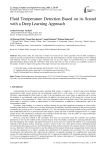
Fluid Temperature Detection Based on its Sound with a Deep Learning Approach
Статья научная
The present study, the main idea of which was based on one of the questions of I.P.T.2018 competition, aimed to develop a high-precision relationship between the fluid temperature and the sound produced when colliding with different surfaces, by creating a data collection tool. In fact, this paper was provided based on a traditional phenomenological project using the well-known deep neural networks, in order to achieve an acceptable accuracy in this project. In order to improve the quality of the paper, the data were analyzed in two ways: I. Using the images of data spectrogram and the known V.G.G.16 network. II. Applying the data audio signal and a convolutional neural network (C.N.N.). Finally, both methods have obtained an acceptable precision above 85%.
Бесплатно

Frame work for expression invariant face recognition system using warping technique
Статья научная
Facial expressions, usually has an adverse effect on the performance of a face recognition system. In this investigation, expression invariant face recognition algorithm is presented that converts input face image with an arbitrary expression into its corresponding neutral facial image. In the present study, deep learning algorithm is used to train classifiers for reference key-points, where key-points are located and deep neural network is trained to make the system able to locate the landmarks in test image. Create an intermediate triangular mesh from the test and reference image and then warp it using affine transform and take the average of the normalized faces. To extract the features presented in the result image shift invariant feature extraction technique is used. Finally, results are compared and the recognition accuracy is determined for different expressions. The present work is tested on three different databases: JAFFE, Cohn-Kanade (CK) and Yale database. Experimental results show that the expression invariant face recognition method is very robust to variety of expressions and recognition accuracy is found to be 97.8 %, 96.8% and 95.7% for CK, JAFFE and Yale databases respectively.
Бесплатно
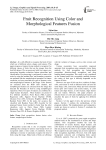
Fruit recognition using color and morphological features fusion
Статья научная
It is still difficult to recognize the kind of fruit which are of different colors, shapes, and textures. This paper proposes a features fusion method to recognize five different classes of fruits that are the images from the fruit360 dataset. We are processed with four stages: pre-processing, boundary extraction, feature extractions, and classification. Pre-processing is performed to remove the noise by using the median filter, and boundary extraction are operated with the morphological operation. In feature extraction, we have extracted two types of features: color, and morphological features of the image. Color features are extracted from the RGB color channel, and morphological features are extracted from the image that detected the boundary of fruit by using morphological operations. These two types of features are combined in a single feature descriptor. These features are passed to five different classifiers: Naïve Bayes (NB), Logistic Regression (LR), Support Vector Machine (SVM), Decision Tree (DT), K-Nearest Neighbor (KNN), and Random Forest (RF). In the study, the accuracy that classified with Random Forest (RF) classifier for the proposed feature fusion method is better than the other classifiers, such as Naïve Bayes (NB), Logistic Regression (LR), Support Vector Machine (SVM), Decision Tree (DT), K-Nearest Neighbor (KNN).
Бесплатно
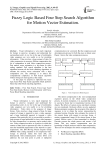
Fuzzy Logic Based Four Step Search Algorithm for Motion Vector Estimation
Статья научная
Visual information is very much important for human to perceive, recognize and understand the surrounding world. As we live in the age of multimedia video sequences are very useful to us for providing information. Video involves a huge amount of data. So video compression is necessary Motion compensation has lot of computation in total video compression process. Fast motion vector estimation is a key-factor in video coding standard. Full search algorithm is the best algorithm between all the block matching algorithms to estimate the motion vector estimation with a huge computation cost. The challenge is to reduce the computational complexity of Full Search algorithm without losing too much quality at the output. In this paper we propose to implement the fuzzy logic based Four Step Search algorithm which performs better than other block matching algorithms.
Бесплатно
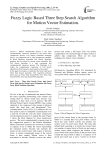
Fuzzy Logic Based Three Step Search Algorithm for Motion Vector Estimation
Статья научная
Motion compensation process is the most computationally expensive operation in the entire video compression process. Fast motion estimation technique plays a very important role in video compression standard. In Block Matching Algorithm Full Search Algorithm produces the best result for motion vector estimation. But Full Search algorithm is a time consuming and computationally expensive process. The Challenge is to reduce the computational complexity of Full Search algorithm without losing too much quality at the output. In this paper we propose to implement the fuzzy logic based Three Step Search algorithm. This Algorithm performs better than the Three Step Search(TSS), New Three Step Search(NTSS), Four Step Search(FSS) algorithm.
Бесплатно

Fuzzy entropy based impulse noise detection and correction method for digital images
Статья научная
Impulse noise is the prime factor which reduces the quality of the digital image and it erases the important details of the images. De-noising is an indispensable task to restore the image features from the corrupted low- quality images and improve the perceptual quality of images. Several techniques are used for image quality enhancement and image restoration. In this work, an image de-noising scheme is developed to detect and correct the impulse noise from the image by using fuzzy entropy. The proposed algorithm is designed in two phases, such as noise detection phase, and correction phase. In the noise detection phase, the fuzzy entropy of pixels in a window of interest (WoI) is computed to detect whether the pixel is noisy or not. The Fuzzy entropy of pixel greater than specified alpha cut value will be considered as noise pixel and submitted to correction phase. In the correction phase noise pixel value is replaced with a fuzzy weighted mean of the un-corrupted pixels in the WoI. The proposed Fuzzy entropy based impulse noise detection and correction method are implemented using MATLAB. The experimentation has been carried out on different standard images and the analysis is performed by comparing the performance of the proposed scheme with that of the existing methods such as DBA, MDBUTMF, AMF, NAFSM, BDND, and CM , using PSNR, SSIM, and NAE as metric parameters. The proposed method will give good results compared to state of the art methods in image restoration.
Бесплатно
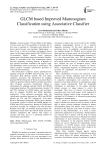
GLCM based Improved Mammogram Classification using Associative Classifier
Статья научная
Among women, 12% possibility of developing a breast cancer and 3.5% possibility of mortality due to this cause is reported [1]. Nowadays early detection of breast cancer became very important. Mammogram - a breast X-ray is used to investigate and diagnose breast cancer. In this paper, authors propose GLCM (Grey Level Co-occurrence Matrix) feature based improved mammogram classification using an associative classifier. Mining of association rules from mammogram dataset discovers frequently occurring patterns. It depends on user specified minimum confidence and support value. This dependency causes an increase in search space. The authors propose two-phase optimization procedure to overcome these limitations. The initial phase comprises feature optimization by adopting proposed PreARM (Pre-processing step for Association Rule Mining) method. The next phase comprises association rule optimization by adopting proposed ESAR (Extraction of Strong Association Rules) method to generate efficient, highly correlated and robust rules. Proposed associative classification method is substantiated by adapting authentic MIAS and DDSM mammogram database. The experimentation concedes 91% and 90% trimming of GLCM features and association rules by adopting PreARM and ESAR algorithms respectively. Using optimized association rules, the classification accuracies procured for MIAS and DDSM datasets are 92% and 94% respectively. Area under Receiver Operating Characteristic (ROC) curves obtained by proposed system for MIAS and DDSM datasets are 0.9656 and 0.9285 respectively. Results of GLCM based associative classifier are compared with GLCM based Random Forest (RF), an ensemble learning method. The experimental result shows that GLCM based associative classifier outperforms RF method with respect to accuracy and AUC, and it is a promising method for mammogram classification.
Бесплатно

GPU-Based Volume Rendering for 3D Electromagnetic Environment on Virtual Globe
Статья научная
Volume rendering is an important and effect algorithm to represent 3D volumetric data and 3D visualization on electromagnetic environment (EME) is one of the most important research fields in 3D battlespace. This paper presents a novel framework on visualizing the 3D EME by direct volume rendering on virtual globe. 3D power volumetric data is calculated based on the Longley-Rice radio propagation model (Irregular Terrain Model, ITM), which takes into account the effects of irregular terrain and atmosphere, and we use GPU-accelerated method to compute the EME volumetric data. The EME data are rendered using direct volume rendering method on virtual globe by assigning different color and opacity depending on user’s interactive input with color picker. We also propose an interactive method to show detailed information of EME at given place. This approach provides excellent decision supporting and plan-aiding for users.
Бесплатно
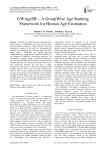
GWAgeER – A GroupWise Age Ranking Framework for Human Age Estimation
Статья научная
The task of estimating the age of humans from facial image is a challenging one due to the non-linear and personalized pattern of aging differing from one individual to another. In this work, we investigated the problem of estimating the age of humans from their facial image using a GroupWise age ranking approach complemented by ageing pattern correlation learning. In our proposed GroupWise age-ranking approach, we constructed a reference image set grouped according to ages for each individual in the reference set and used this to obtain age-ranks for each age group in the reference set. The constructed reference set was used to obtain transformed LBP features called age-rank-biased LBP (arLBP) features which were used with attached age-ranks to train an age estimating function for predicting the ages of test images. Our experiments on the publicly available FG-NET dataset and a locally collected dataset (FAGE) shows the best known age estimation accuracy with MAE of 2.34 years on FG-NET using the leave-one-person-out strategy.
Бесплатно

Gait Recognition for Human Identification Using Fourier Descriptor and Anatomical Landmarks
Статья научная
This paper presents a gait recognition method which is based on spatio-temporal movement characteristics of human subject with respect to surveillance camera. Different measures, like leg rise from ground (LRFG), the angles created between the legs with the centre of Mass (ABLC), angles created between the Centre of Mass Knee and Ankle with the (CKA), angles created between Centre of Mass, Wrist and knee (CWK), the distances between the control points and centre of Mass (DCC) have been taken as different features. Fourier descriptor has been used for shape extraction of individual frames of a subject. Statistical approach has been used for recognition of individuals based on the n feature vectors, each of size 23(collected from LRFG, ABLCs, CKA, CWK and DCCs) for each video frame. It has been found that recognition result of our approach is encouraging with compared to other recent methods.
Бесплатно
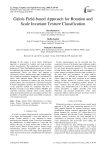
Galois field-based approach for rotation and scale invariant texture classification
Статья научная
In this paper, a novel Galois Field-based approach is proposed for rotation and scale invariant texture classification. The commutative and associative properties of Galois Field addition operator are useful for accomplishing the rotation and scale invariance of texture representation. Firstly, the Galois field operator is constructed, which is applied to the input textural image. The normalized cumulative histogram is constructed for Galois Field operated image. The bin values of the histogram are considered as rotation and scale invariant texture features. The classification is performed using the K-Nearest Neighbour classifier. The experimental results of the proposed method are compared with that of Rotation Invariant Local Binary Pattern (RILBP) and Log-Polar transform methods. These results obtained using the proposed method are encouraging and show the possibility of classifying texture successfully irrespective of its rotation and scale.
Бесплатно
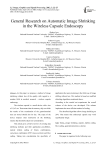
General Research on Automatic Image Shrinking in the Wireless Capsule Endoscopy
Статья научная
In this paper we propose a method of image shrinking without loss of the quality with regard to a modern field in medical research - wireless capsule endoscopy. The wireless capsule is a small devise with a size of 1,5x2 cm. That means that the memory chip on which the results of the examination of the gastrointestinal tract are stored should also be tiny. The scope of the device imposes strict restrictions on the shrinking scheme that should be taken into consideration. This article gives a brief overview of existing data shrinking methods and their application possibilities, namely triplets coding of binary combinations, conversion combination MTF (move-to-front) and Rice coding. Taking into consideration the specificity of application the more promising is the third way of image shifting without loss. This method is based on modified shrinking algorithms mentioned above. According to the carried out experiments the overall scheme of the device was developed. This scheme implements the most efficient method of coding. The described algorithm allows image shrinking on 20%. That means that endoscopic capsule may work significantly longer.
Бесплатно
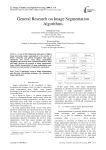
General Research on Image Segmentation Algorithms
Статья научная
As one of the fundamental approaches of digital image processing, image segmentation is the premise of feature extraction and pattern recognition. This paper enumerates and reviews main image segmentation algorithms, then presents basic evaluation methods for them, and finally discusses the prospect of image segmentation. Some valuable characteristics of image segmentation come out based on a large number of comparative experiments.
Бесплатно
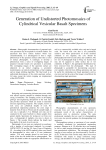
Generation of Undistorted Photomosaics of Cylindrical Vesicular Basalt Specimens
Статья научная
Photographic documentation of prepared rock core specimens may be required for scientific studies. For specimens that have surface features which vary circumferentially, it is advantageous to have a single photomosaic of the specimen surface rather than a series of surface photographs. A technique to develop a photomosaic from a series of overlapping images of prepared vesicular basalt core specimens is presented. The overlapping images of the specimen surface are subjected to an initial cropping, a geometric transformation, an intensity interpolation, a final cropping, and an image stitching algorithm. The final result is an undistorted photomosaic of the entire specimen surface. All steps except the initial cropping are implemented within MATLAB®.
Бесплатно

Статья научная
The introduction of remote sensing techniques had lead us into a new race of advanced data processing applications. The analysis ready data is also a part of it which is generated at the producer end to facilitate its user to directly go on to the application part. This paper highlights the generation, processing and cloud applications of the Analysis Ready Data (ARD) using ISRO's Satellites Resourcesat-2 and Resourcesat-2A's LISS-3 sensor data. The proposed work includes use of terrain corrected data for generating Radiance, Top of Atmosphere (ToA) Reflectance, Normalized Difference Vegetation Index (NDVI), Enhanced Vegetation Index (EVI) and Time series analysis with pixel level Quality Assessment (QA) for all the generated data products. A graphical user interface has been developed for online ordering of data by the user. This paper also highlights the implementation of the developed application in cloud platform using the cloud computing model, Platform as a Service (PaaS).This facilitates the users to generate the ARD products from any device, facilitating a quick and all time available transmission rate for the customers.
Бесплатно
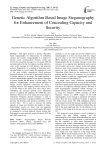
Genetic Algorithm Based Image Steganography for Enhancement of Concealing Capacity and Security
Статья научная
This paper proposes a Genetic Algorithm based steganography for enhancement of embedding capacity and security. Steganography is a method to provide secret communication between sender and receiver by concealing message in cover image. LSB bit encoding method is that the simplest encoding method to cover secret message in color pictures and grayscale pictures. Steganalysis is a method of detecting secret message hidden in a cover image. RS steganalysis is one of the most reliable steganalysis which performs statistical analysis of the pixels to successfully detection of hidden message in an image. This paper presents a secured steganography method using genetic algorithm to protect against the RS attack in color images. The proposed steganography scheme embeds message in integer wavelet transform coefficients by using a mapping function. This mapping function based on GA in an 8x8 block on the input cover color image. After embedding the message optimal pixel adjustment process is applied. By applying the OPAP the error difference between the cover image and stego image is minimized. Frequency domain technique is used to increase the robustness of proposed method. Use of IWT prevents the floating point precision problems of the wavelet filter. GA is used to increase the hiding capacity of image and maintains the quality of image. Experimental results are shows that the proposed steganography method is more secured against RS attack as compared to existing methods. Result showed that Peak signal to noise ratio and image utilization, 49.65 db and 100% respectively.
Бесплатно
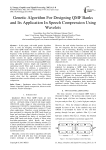
Genetic Algorithm For Designing QMF Banks and Its Application In Speech Compression Using Wavelets
Статья научная
In this paper, real-coded genetic algorithm (GA) is used for designing two-channel quadrature mirror filter (QMF) banks based on the Kaiser Window. The shape of the Kaiser window and the cutoff frequency of the prototype filter are optimized using a simple GA. The optimized QMF banks are exploited as mother wavelets for speech compression based on discret wavelet transform (DWT). The simulation results show the efficiency of the GA for designing QMF banks using adjustable windows length and especially for optimizing wavelet filters used in speech compression based on wavelets. In addition, a comparative of performance of the developed wavelets filters using GA and others known wavelets is made in term of objective criteria (CR, SNR, PSNR, and NRMSE). The simulation results show that the optimized wavelets filters outperform others wavelets already exist used for speech compression.
Бесплатно
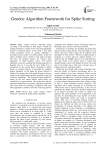
Genetic Algorithm Framework for Spike Sorting
Статья научная
Spike sorting involves clustering spikes according to the similarity of their shapes. Usually the sorting procedure is carried out by extracting appropriate features of neuronal spikes. In this study a new spike sorting procedure based on genetic algorithm is developed which contains two distinct phases. In the first phase a B-spline curve is fitted to each spike waveform and then the optimal features are selected from parameters of fitted B-spline curves. The genetic algorithm is used for searching the optimal parameters of B-spline curve in a way that the curve fitting error is minimized. In the second phase, clustering of spikes based on extracted features is performed by applying genetic algorithm. In this phase the fitness function is defined in a manner that both spatial distances between objects in the feature space and their similarity in the real world are considered. The proposed sorting method is tested on the real neural dataset which firstly are classified by an expert human. The results show that the proposed method based on genetic algorithm framework gives fewer errors of clustering in comparison with some other approaches currently used in the clustering purposes.
Бесплатно
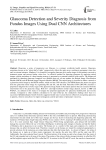
Glaucoma Detection and Severity Diagnosis from Fundus Images Using Dual CNN Architectures
Статья научная
Glaucoma, a series of progressive eye illnesses, is a primary worldwide health concern. Glaucoma, sometimes known as the "silent thief of sight," progressively affects the optic nerve, resulting in permanent vision loss and, in extreme instances, blindness. It is essential to recognize glaucoma in its earlier stages so that patients can receive treatment sooner and prevent further vision loss. An effective method for detecting glaucoma by analyzing retinal images with the assistance of a deep learning strategy is presented as a potential solution in this article. The framework presented for detecting glaucoma comprises two modules that rely on one another: the Retinal Image Classification Module (RICM) and the Retinal Image Diagnosis Module (RIDM). The retinal image is classified as either a normal or a glaucoma retinal image by the RICM module, which uses the CNN classifier. The RIDM detects the neuro rim region from the glaucoma retinal image by segmenting OD and OC, and the Dual Functional CNN (DFCNN) classifier is proposed to diagnose the severity stages of the glaucoma image based on the feature patterns that are extracted from the neuroretinal rim in the glaucoma image. Both low- and high-resolution retinal image datasets, known as HRF and PAPILA, are utilized in this study to investigate the proposed approaches for glaucoma identification and severity estimate. Compared to other methods considered to be state-of-the-art, the simulation's findings show that it is successful. Ophthalmologists benefit from the suggested model since it assists them in effectively recognizing glaucoma in patients, which in turn allows for improved diagnosis and the prevention of premature vision loss.
Бесплатно

